Your handy 1949-53 Jaguar XK120 buyer’s guide
After more than a 120 years of constant improvement in car building, it’s easy to look at the XK120 and think “What a sweet old car,” the wistful way you’d look at a Curved Dash Olds or a Benz Patent-Motorwagen. Don’t make the mistake of confusing this glorious Jag for some dusty relic. When it was introduced at the 1948 London Motorfair at Earls Court, the XK120 was a revelation. This was a revolutionary sports car—not only in terms of design, but also technology—capable of hauling itself, a driver and a passenger to 120 miles per hour. At the time, that was faster than any human had gone in any car.
Model Overview
1949
We’re not going to spend a ton of time on the XK120’s development, because some of the world’s most noted automotive historians have written entire books on the subject. Let’s sketch out the basic details of the prototype from 1948, though, because this was a concept car that accidentally made it to wide-scale production, in a form that was almost identical to the car on the turntable.
The start was the XK engine, a 3.4-liter dual-overhead-cam, inline six-cylinder, twin SU H6-carbureted monster mated to a four-speed Moss gearbox. The 160-hp engine had been in stages of development in one form or another since 1944, beginning with the four-cylinder pushrod XG engine. DOHC engines weren’t exactly new at this point, having arrived in some limited production in 1926 and used throughout the 1930s, but they were at the time restricted to exclusive, low-production cars like the Stutz DV-32, or the Duesenberg Model J.
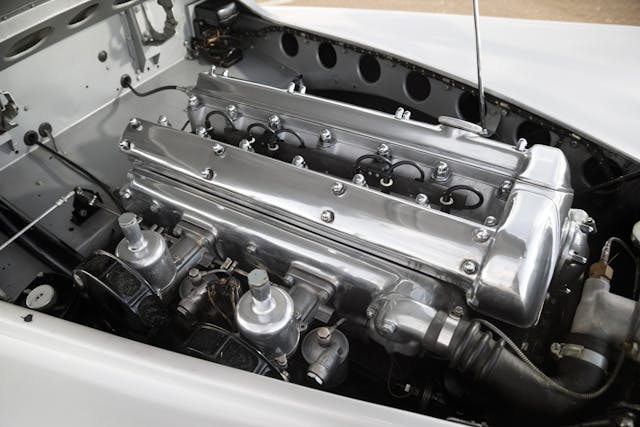
The frame was donated by the Jaguar Mark V, shortened and narrowed, and equipped with a double wishbone front suspension with torsion bars, and a live rear axle suspended by leaf springs. Brakes were drums all around and would stay that way throughout the XK120 production run. The steering was a manual worm and nut box with an enormous wheel set close to the driver’s chest.

The Jaguar XK engine was intended to power a luxurious saloon car (sedan). But while the engine was ready in 1948, the Mark VII wasn’t, and it wouldn’t be until the 1950 model year. With the 1948 Earl’s Court show looming just two months away, Jaguar’s famously autocratic co-founder and lead designer, William Lyons, penned the shape of a new sports car in just four weeks. Using the design, engineers modified a Jaguar Mark V chassis, draped it in some of the most sinuous bodywork ever produced and packed the Jaguar XK120 Super Sport off to the event.
The bodywork on the prototype and the very first XK120s was aluminum skin over an ash framework, but that was when the plan was to build just 200 cars in total. The public’s reaction disabused everyone at Jaguar of that game plan. With a price of £999 (Adjusted for inflation, about £37,150 or $51,000, about 1.5 times the price of a Cadillac Series 62), the Jaguar was expensive, but not Duesenberg expensive. All of the 242 alloy cars produced between 1949 and 1950 were built at the Holbrook Lane facility in Coventry, U.K.
Initially, there was one body style: the Open Two-Seater, or OTS in the U.K., and informally “Roadster” here. No roof. No windows. A cutdown windscreen. Hope for good weather. For a car that was half again as expensive as a Cadillac, they were not luxurious inside. The seats were nicely upholstered in leather, but the door panels were lightly upholstered card stock, and the dash wasn’t much more elaborate. The XK120 featured a full array of clocks from Smiths, dominated by a 140-mph speedometer and a 6000-rpm tachometer.

The “XK” part made sense at the 1948 show, being named for the XK engine it packed under its long bonnet. But at the time of the show in October that year, the “120”— named for the speed in mph the car could attain—was just a guess. The car wouldn’t actually achieve a speed of 126.448 miles per hour, a production car record, for another seven months.
Nevertheless, the Jaguar XK120 prototype caused a literal sensation across the globe, and led to the first example delivered in the United States going famously to Clark Gable. According to chassis numbers at the Jaguar Heritage Trust, which keeps intricate records of production, a total of 27 right hand drive Roadsters and 70 left-hand-drive examples were produced.
1950

If Jaguar was going to actually ramp up to full-scale production, steel was the way it was going to happen, and in the 1950 model year, the production began to shift to steel sheetmetal wrapped over an ash framework. That shift, combined with the increased production, were the big revisions for 1950. The Jaguar Heritage Trust shows that for 1950, Jaguar produced 490 right-hand drive Roadsters and 1,025 left-hand drive Roadsters.
1951

The XK120 Fixed Head Coupé (FHC) arrives for the 1951 model year. These were intended to be much more practical automobiles, and with the exception of two right-hand-drive cars, they were all headed to the export market.
The FHC debuted in March of 1951 at the Geneva Auto Show. Unlike the Spartan XK120 Roadster, the FHC began to play the luxury angle along with the practicality of an enclosed passenger compartment with a fixed roof and roll-up windows. Instead of a simply upholstered dash, the FHC driver stared at a gorgeously figured slab of walnut. It was a gentleman’s club on wheels.

The XK120’s bodywork, by the way, isn’t just a Roadster with a roof hastily grafted on top. The Roadster’s windscreen is supported by chrome uprights bolted to the bulkhead, while the FHC has an A-pillar molded to the cowl. The roof is an almost egg-shaped pod that not only covers the passenger compartment, but also provides some cargo room on a package shelf behind the seats—at least large enough for a lapdog and a handbag. Along with the winding windows, FHC drivers got a pair of triangular vent windows, fixed quarter windows and a letter-slot sized backlight. The doors had chrome exterior handles.
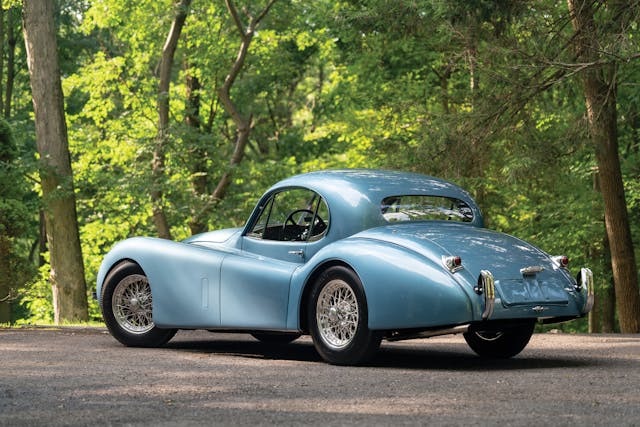
1951 also introduced the “SE” specification XK120, via Service Bulletin 95A. Along with wire wheels for better brake cooling, SE cars boosted horsepower to 180 at 5300 rpm with higher lift cams and dual exhaust pipes. The same service bulletin also announced that Jaguar would offer a close-ratio gearbox for competition use,
According to the Jaguar Heritage Trust, for 1951 Jaguar built 434 right-hand drive Roadsters, 699 left-hand drive Roadsters, 2 right-hand drive Fixed Head Coupés, and 214 left-hand drive Fixed Head Coupés.
1952

1952 essentially carried on with no major changes from the 1951 model year. But it was the busiest year yet for XK120 production. The Jaguar Heritage Trust shows for 1952: 110 right-hand drive Roadsters, 1592 left-hand drive Roadsters, 1 right-hand drive Fixed Head Coupé, and 1356 left-hand drive Fixed Head Coupés.
1953
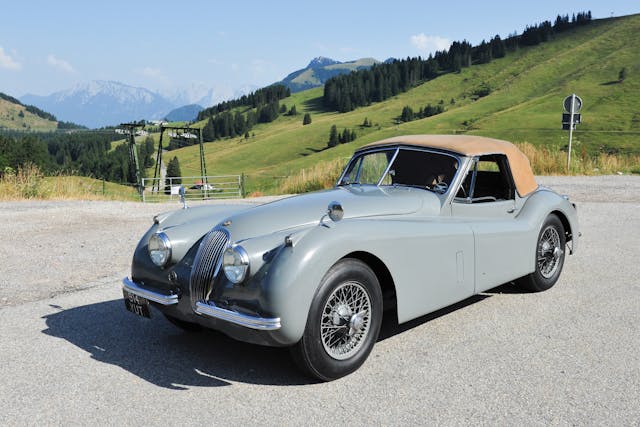
This model year introduced another all-new model, the XK120 Drop Head Coupé or DHC. The DHC sought to split the difference between the sheer exhilaration of the open-top motoring and the practicality of a roof and good windows.
Like the FHC, the DHC has a true A-pillar, rather than bolt-on windscreen uprights. Similarly, the doors were shared with the XK120 FHC, with chrome exterior door handles, winding windows and pivoting vent windows. In place of the hard roof is a folding canvas top, lined for warmth and noise reduction inside. And similar to the XK120 FHC, there’s a small package shelf behind the seats. Buyers also got the more luxurious walnut dashboard in the Drop Head Coupé.
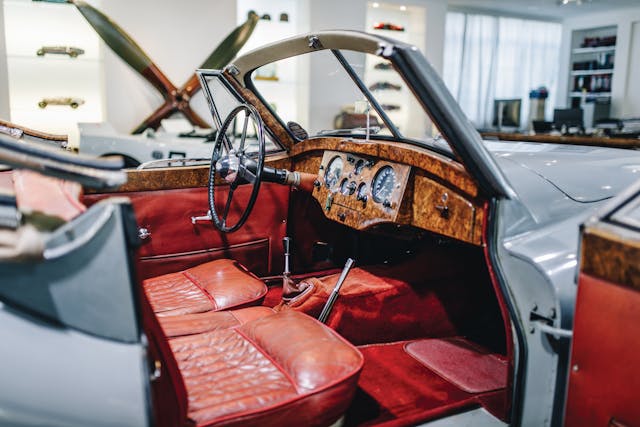
Beginning in 1953, agents and dealers could build their own version of an SE (or an M for “Modified” XK120 in the US), with a C-Type head, and larger twin SU H8 carburetors for a boost to 210 hp. Simultaneously, with some head and manifold work at the dealership, the C Type head and twin Weber DCOE carbs could bring the horsepower figure to 220.
Jaguar Heritage Trust records for 1952 show 107 right-hand-drive Roadsters, 1202 left-hand-drive Roadsters, 106 right-hand drive Fixed Head Coupés, 736 left-hand-drive Fixed Head Coupés, 167 right-hand-drive Drop Head Coupés, and 101 left-hand-drive Drop Head Coupés.
1954

By August of 1954, XK120 production had ceased to make way for the all-new XK140. There were no major changes for the 1954 model year. The Jaguar Heritage Trust shows for 1952, Jaguar produced: 22 right-hand-drive Roadsters, 1846 left-hand-drive Roadsters, 83 right-hand-drive Fixed Head Coupés, 176 left-hand-drive Fixed Head Coupés, 126 right-hand-drive Drop Head Coupés, and 369 left-hand-drive Drop Head Coupés.
Before you buy
This may come as a shock, but with a British car made of thin steel sheetmetal over ash framework, you need to be aware of rust. Everywhere. In the fenders, around the headlight buckets, on the frame, in the door pillars, etc. If you’re one of the well-heeled who might be interested in an alloy-bodied car, don’t think those are totally immune from corrosion, either.
On the plus side of the ledger, these are body-on-frame cars, and for the purposes of restoration, that’s “easier” than a monocoque. Regardless, it’s imperative to get a prospective XK120 on a lift not just to see what’s underneath, but to see if the doors will open and close while it’s up there. If they won’t, you’ve got a car that’s going to require significant work in the near future. The number of cars with original paint have to be in the ones and twos at this point, if they exist at all. Despite their age and value, a good number of people still use these cars regularly, and you’ll see examples (like the one in our video) with visible bubbling. Sketchy paint is also worth noting.

Thousands of these cars had their plain steel wheels and center caps jettisoned in favor of the wire wheels that were part of the SE models, to the point where you hardly see the steel wheels. That’s too bad, because despite the nominally better brake cooling offered by the wire wheels, the body-color steelies look great.
XK120s were hand-fitted vehicles at the factory, which means each unit is a bit on the unique side. If you’re embarking on your first restoration, maybe consider a Camaro or a Spitfire before you work you way up to something like this. Lucas electrics get a bad rap, but this is about the simplest electrical system in an automobile. The problem now is the age. Even cars that had their wiring sorted in the 1980s are going to be riding around with 35-year-old wiring. Don’t be surprised if it needs attention.
Like the electrical system, the engines have likely seen rebuilds and upgrades over the years to cure front and rear main seal leaks and corroded head gaskets. Older restorations are probably ready for their second major overhauls at this point, but XK120s that were restored 30 to 40 years ago probably didn’t get used the way they did when they were new.

The big issues to address—if they haven’t been already—are related to cooling. You’ll need an aluminum radiator and an electric fan. That’s pretty much mandatory if you choose to drive one. If your intended car is to be trailered everywhere, you’ll probably opt for authenticity rather than functionality. Similarly, a driver XK120 will benefit from an electric fuel pump and an electronic ignition conversion from a supplier like Pertronix.
A boatload of these cars have had five-speed conversions now, because the Moss ‘boxes are getting old. There are folks like Quantum Mechanics Ltd. in Connecticut that specialize in rebuilding the Moss gearbox, so you can always investigate that route. Early XK120s used ENV-type differentials, which are often converted to later Salisbury units. From 1952 forward on, the XK120 used the Salisbury 2HA differential, which is generally stout. Major parts are getting scarce, though, and it’s not surprising to see that differential swapped with something from Dana.
Don’t be surprised to find XK120s with power steering upgrades, especially if they were driven often. The dinner table-sized steering wheel helps, but it definitely still requires effort to turn unassisted at low speeds.
Valuation
It should be pretty obvious that the initial handful of alloy Roadsters are dramatically more expensive than the steel-bodied cars. The Hagerty Valuation team says that these versions generally carry a price tag over twice as much as the next most expensive body style, but please check here for the most up to date values.
Despite being more rare, the Drop Head Coupés generally trade for about the same as the Roadster. If you could compare this car to something in a stock portfolio, the XK120 would be IBM, experiencing some ups and downs over the years, but with minor fluctuations over the long run . A #2-condition (Excellent) SE that might have traded for $137,000 in 2009 probably peaks at $138,000 today.

SE cars aren’t dramatically more expensive than a standard XK120. A 1952 XK120 in #2 condition hovers around $130,000. Is the 20 hp worth $8000? The highest price realized for an XK120 in Bring A Trailer’s listings over the last two years was $276,000, but that was Clark Gable’s car. In the last 12 months, an 1950 alloy XK120 traded hands for $199,652. Meanwhile, back on Earth, there’s been solid action in the $92,000 to $95,000 range, with representatives including a Fixed Head Coupé, a Roadster with a five-speed conversion, and a Drophead Coupé.
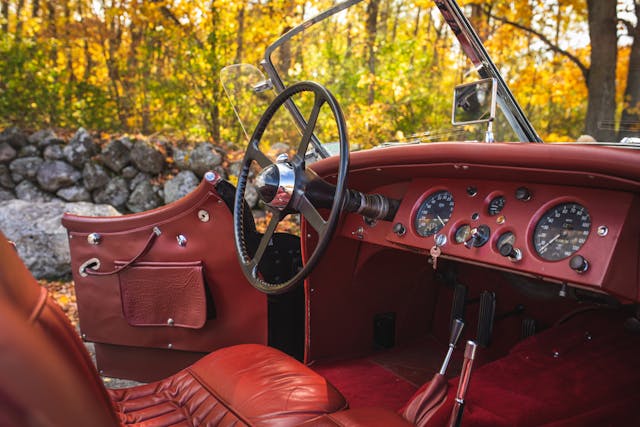
A full half of the insurance quote requests processed by Hagerty were from baby boomers, who represent 39 percent of the total collector car market. Preboomers made up the next chunk at 24 percent of the quote requests, which is, again, an outsized proportion compared to this demographic’s claim to just seven percent of the overall hobby. Gen Xers, who represent 31 percent of the market, only requested 17 percent of the quotes Hagerty processed. Millennials were an 8 percent slice of the quote pie, making up 5 percent of the market overall.
The XK120 is one of the world’s most alluring cars, full stop. None of that detracts from just how wonderful these cars are to drive. The exhaust note is magic. The butt-on-the-tarmac driving position behind that giant tiller and long hood is unlike anything from the last six decades. Despite archaic technology, this is a car built to go fast for long periods of time, provided you’re brave enough. An hour in an XK120 is pure time travel, and that’s as true then as it is now.


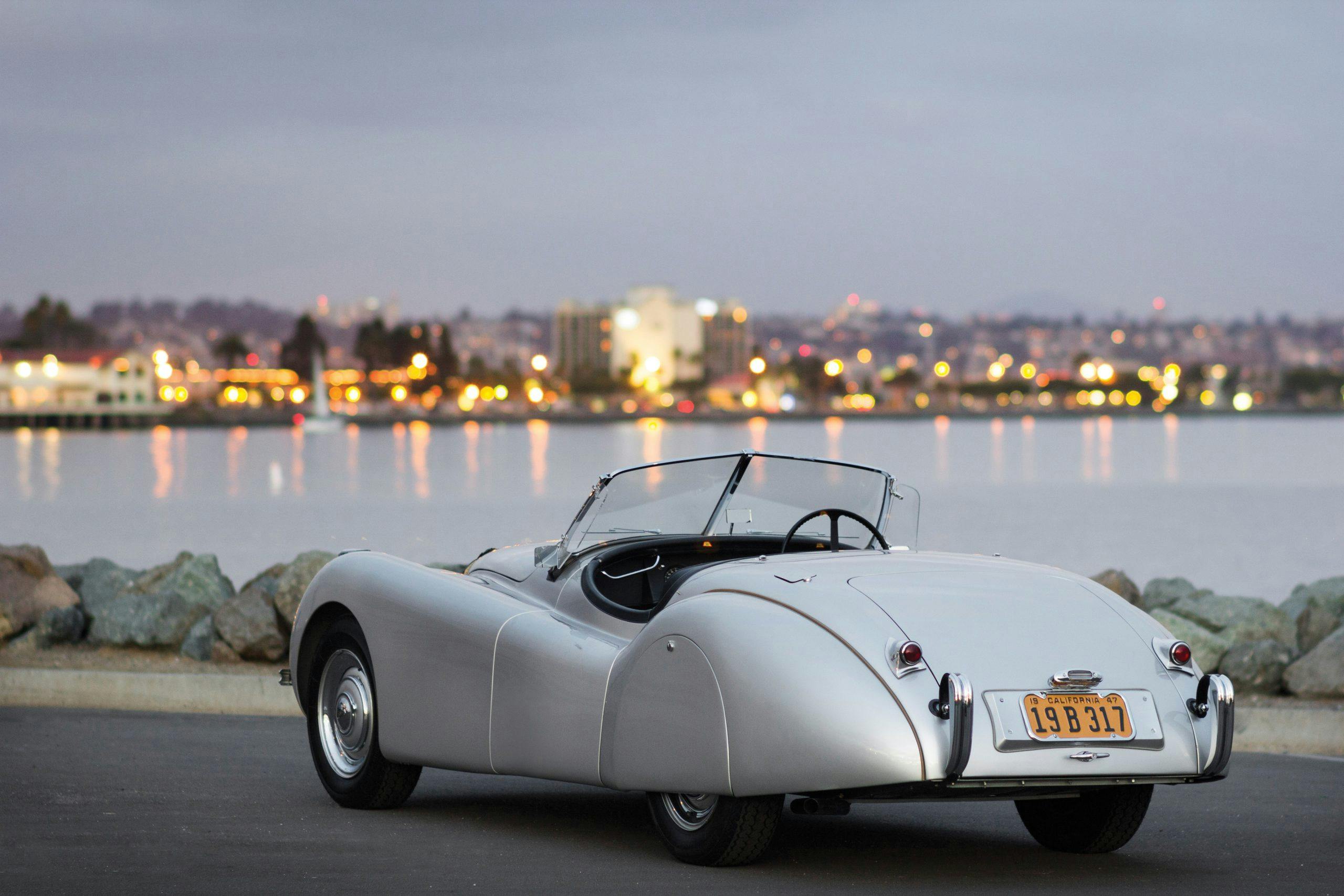
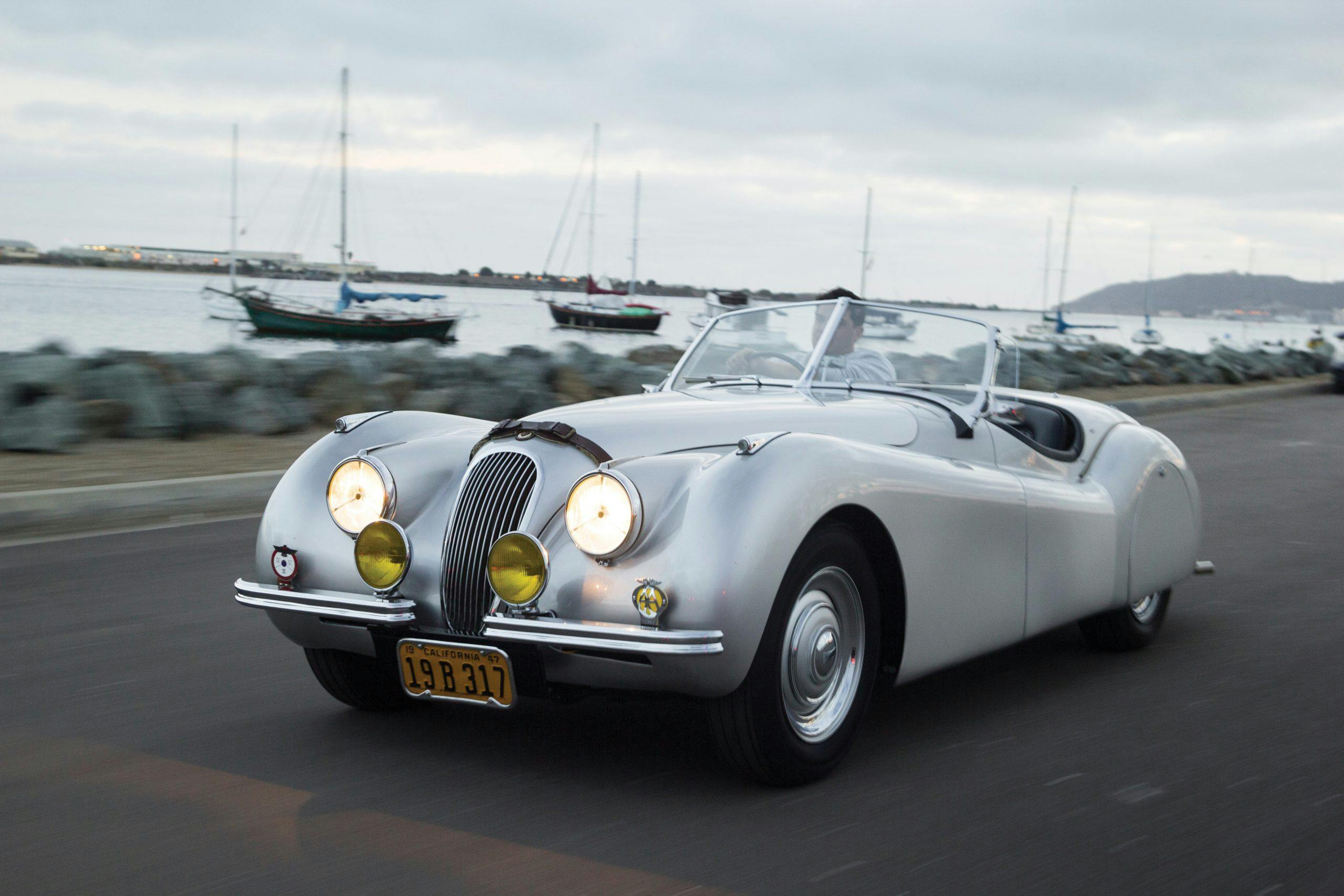


Thank you for this trusted presentation on the 120. in my senior years it is very unlikely I will ever attain one . A Canadian RCAF ACE highly decorated flying Spitfires9’s, Hawker Typhoons with the RAF with 11 V1 , 109 and 190 kills, David Ness had a small factory in my town and drove a 1952 white 120 roadster. Quite something in a small Ontario town then to see him bombing around
I have one, 1953 dhc. Bought in1963 from my father in law and brother in law for $275, that’s dollars. Drove it like a street car for many summers. Got stopped one night in!972 by a nys trooper. He said, “How many people you got in that thing”? Just Peter, David and that’s Paulie on the back shelf, Sir. What was I doing wrong, Officer? Nothing, I just wanted to get a closer look at your beautiful automobile! true story
Our fathers XK120 LOE 3 is still around and may now have it’s ”C Type” head back on. Every year from new in 1951 it went back to Jaguars to be checked and upgraded for the following years competions. LOE 3 was moved on in the early 1960’s. The XK120 in the Jaguar Heritage Trust collection OOF 748 was sold new by Frank Grounds Ltd of Aston, Birmingham.